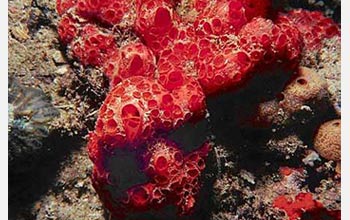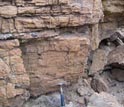News Release 09-015
Fossil Steroids Record the Advent of Earliest Known Animals
Demosponges appeared 635 million years ago in era of climatic extremes and evolutionary developments

Demosponges, the earliest known animals, today live along the coast, and in the sea's depths.
February 4, 2009
This material is available primarily for archival purposes. Telephone numbers or other contact information may be out of date; please see current contact information at media contacts.
Using compounds preserved in sedimentary rocks more than 635 million years old, researchers have found some of the earliest evidence for the existence of animals.
Demosponges thrived in the shallow coastal waters of what is now Oman, according to scientist Gordon Love of the University of California at Riverside and colleagues from MIT and other institutions.
They report the results of their research in this week's issue of the journal Nature.
"Demosponges appeared during the Neoproterozoic era, 1,000 to 542 million years ago, an era of climatic extremes and biological evolutionary developments culminating in the emergence of animals and new ecosystems," said Love.
"These sponges currently represent the oldest evidence for animals in the fossil record."
The preserved compounds Love and colleagues discovered in these sponges, called steranes, exist in a wide variety of biochemical configurations, according to Stephen Macko, program director in the National Science Foundation (NSF)'s Division of Earth Sciences, which funded the research.
"The compounds are also known as 'biomarkers,' indicating that they can be traced directly to living organisms," said Macko.
The biomarker Love and colleagues identified, 24-isopropylcholestane, is found in living demosponges, and now has been observed in 635 million-year-old rocks, but was not seen in older samples of the same rock formation.
"The fact that these biomarkers were found in samples associated with sedimentary rocks that formed in shallow waters," said Macko, "lends support to the hypothesis that demosponges arose in warm shallow coastal seas."
Feeding on dissolved and particulate organic debris in the water, these animals eventually migrated to the deep sea. They now reside there, as well as in shallower coastal waters.
-NSF-
-
A rock outcrop in northern Oman contains evidence of fossil demosponges.
Credit and Larger Version
Media Contacts
Cheryl Dybas, NSF, (703) 292-7734, email: cdybas@nsf.gov
The U.S. National Science Foundation propels the nation forward by advancing fundamental research in all fields of science and engineering. NSF supports research and people by providing facilities, instruments and funding to support their ingenuity and sustain the U.S. as a global leader in research and innovation. With a fiscal year 2023 budget of $9.5 billion, NSF funds reach all 50 states through grants to nearly 2,000 colleges, universities and institutions. Each year, NSF receives more than 40,000 competitive proposals and makes about 11,000 new awards. Those awards include support for cooperative research with industry, Arctic and Antarctic research and operations, and U.S. participation in international scientific efforts.
Connect with us online
NSF website: nsf.gov
NSF News: nsf.gov/news
For News Media: nsf.gov/news/newsroom
Statistics: nsf.gov/statistics/
Awards database: nsf.gov/awardsearch/
Follow us on social
Twitter: twitter.com/NSF
Facebook: facebook.com/US.NSF
Instagram: instagram.com/nsfgov



